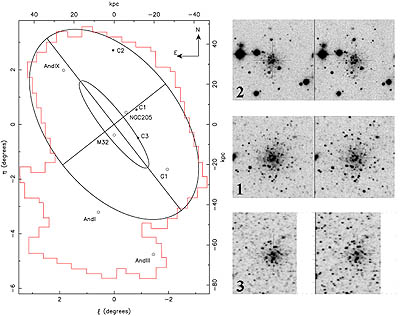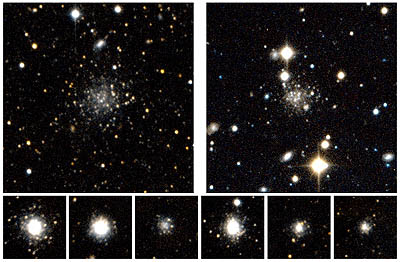A New Population of Star Clusters in the Halo of M31
INT+WFC
Over the past several years the INT WFC has undertaken a major survey of M31, whcih has revealed a wealth
of unexpected substructure, the most prominent being a giant stream of stars near the minor axis. As part
of this study of M31, a search for globular clusters in a large part of the halo has been carried out. Globular
clusters systems are valuable tools for the study of the evolution of their host galaxies, acting as chemical and dynamical probes.
Specifically, most globular clusters are believed to be old objects, and thus provide clues to the earliest epochs of galaxy formation history.
Three extended, luminous globular clusters were discovered during this search for classical clusters. Although having
globular-like colours and luminosities, they have unusually large half-light radii, ∼30 pc (compared to typical values between 1 and 7 pc) and they are hundreds of times less dense — the distances between the stars
are, therefore, much greater.
They lie at projected galactocentric distances of ∼15 to ∼35 kpc.
These objects begin to fill the gap in parameter space between (negligible dark matter) classical globular clusters and (dark matter dominated) dwarf spheroidals, and are unlike
any clusters found in the Milky Way, or elsewhere to date.
The fields visually investigated included the whole INT-WFS M31 survey, an area far into the halo, and an additional region south along the Andromeda Stream,
and towards M33, making a total area of more than 40 deg2. The survey consisted of V- and Gunn i-band images with exposures of between 800 and 1000 s, reaching limiting magnitudes
of i=23.5 and V=24.5, and taken in average seeing of 1.2 arcsec. These images were processed by the INT-WFS pipeline provided by the Cambridge
Astronomical Survey Unit, which includes tools for astrometry, photometry and object description and classification.

|
Figure 1. The location of the new extended globular clusters in relation to major landmarks of the M31 system (open circles), and the survey area (red dotted outline).
The ellipses represent a 2° radius disc aligned and tilted to the inclination of M31 and an oblate halo of axial ratio 0.6 aligned along the major axis. The kpc scales correspond to a distance to M31 of 780 kpc. On the right, V- and i-band
images of the new luminous 'extended' clusters, from the INT–WFS images. Each image is 1 × 1 arcmin 2, with north up and east to the left. Cluster 3 is a partial image as it lies on the edge of an INT–WFS field.
Extracted from Huxor, et al., 2005, MNRAS, 360, 1007. [ JPEG | TIFF].
|
The extended M31 clusters have no known analogues in the Milky Way, where such clusters would certainly have been discovered if they existed, unless hidden by the plane of the Galaxy.
This suggests that they could hold important clues to the differing formation histories of these galaxies. If these clusters were not born with their present morphology then one may speculate that they are the stripped cores of cannibalized
dwarf spheroidal galaxies, or the products of cluster mergers perhaps themselves created in a previous interaction of a gas-rich companion with M31.

|
Figure 2. Above are images of two of the newly discovered clusters. Below them are examples of M31's normal globular clusters, which have similar
luminosities but whose stars are much more concentrated together (and hence the images of the globular clusters are saturated in the centres of the clusters).
Photo credit: Nial Tanvir, Mike Irwin and Avon Huxor. [ JPEG | TIFF].
|
References:
-
A. P. Huxor, N. R. Tanvir, M. J. Irwin, R. Ibata, J. L. Collett, A. M. N. Ferguson, T. Bridges, G. F. Lewis, 2005, "A new population of extended, luminous star clusters in the halo of M31",
MNRAS, 360, 1007.
- Astronomers Discover Mysterious New Star Clusters. RAS National Astronomy Meeting Press Release, 2 April 2005.
|




